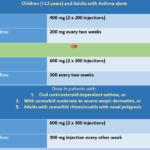Fasenra (Benralizumab) is a human monoclonal antibody directed against Interleukin 5 receptor alpha. It has been approved by the FDA in 2017 for the maintenance treatment of severe allergic asthma.
Other biological medicines that have got FDA approval for allergic asthma include:
Fasenra (Benralizumab) Uses (Indications):
Fasenra (Benralizumab) is only FDA-approved for the maintenance treatment of asthma as an add-on treatment. It is recommended for use in adults and children who are at least 12 years of age.
In children younger than 12 years of age, in patients with status asthmaticus, and eosinophilic conditions other than asthma, Fasenra should not be used.
Fasenra (Benralizumab) Dose in Adults:
Fasenra is administered as a subcutaneous injection that is administered into the skin of the tummy, thighs, and upper arm.
The recommended dose is 30 mg subcutaneously once a month (every four weekly) for three doses followed by 30 mg subcutaneously every 8 weeks [Ref].
Fasnera Dosage forms and how to administer them?
Fasenra is provided in the form of either an autoinjector or a prefilled syringe. Each injection contains 30 mg/mL of the active drug.
The prefilled syringe is administered by healthcare providers only while the autoinjector can be administered by the patient or the caregiver after proper education.
Before administering the drug, it is recommended to keep the carton at room temperature for about 30 minutes to lower its temperature. Inspect the injection.
The solution of the injection should be clear white or slightly yellow. If the solution is opaque or discolored or contains any particulate matter, or the date of expiry has passed, avoid using it. In such situations, consult your healthcare provider.
- After the injection has been kept at room temperature for about 30 minutes, take it out from the carton and hold it from the middle without touching the needle guard activation clips.
- Check the label and date of expiry.
- Hold the injection from the middle and remove the needle cover.
- The injection may contain a small bubble, do not expel the air bubbles.
- Hold the skin by making a fold and inserting the needle at the recommended injection site.
- Push the plunger all the way down until the plunger head is completely between the needle guard activation clips.
- After the injection is injected, release the plunger and remove the needle from the skin.
- Do not recap the needle and dispose of it in a sharp disposal container.
Dose in kidney and Liver diseases:
Although data is limited because the drug has not been studied in patients with various degrees of renal or liver functions.
The manufacturer has not recommended any dose adjustment in patients with liver disease. It can also be safely administered to patients with a CrCl of more than 30 ml/minute. In patients with a CrCl of less than 30 ml/minute, the drug has not been studied.
Dose in Pregnancy and lactation:
Fasenra (Benralizumab) has not been administered to pregnant ladies. Exposure to infants in the third trimester is likely since immunoglobulins can cross the placental barrier.
In animal studies, Fasenra (Benralizumab) exposed infants had suppressed eosinophil counts that gradually improved after 6 months post-partum.
Similarly, it is possible for the drug to get excreted into human breastmilk. Although this has not been clinically studied, breastfeeding infants can get exposed to the drug.
Xolair (Omalizumab) Injection: Uses, Dosing, Side effects, MOA, Price
The decision to breastfeed the infant or continue the drug should be made by the healthcare provider in agreement with the patient’s choices.
Until studies on human pregnancy and breastfeeding are available, it is not recommended to continue the drug in either case.
Fasenra (Benralizumab) Contraindications and Warnings:
Fasenra (Benralizumab) is not recommended for use in patients who are allergic to the drug. It is also not recommended for use in children who are younger than 12 years of age.
Allergic reactions may vary in severity from mild to severe reactions. Mild reactions may manifest as redness, swelling, itching, and pain at the injection site.
Severe allergic reactions may manifest as hypotension, lips and facial swelling, difficulty in breathing, and shock.
Why Does Dupixent Hurt So Much? How to Make Dupixent Hurt Less?
Allergic reactions may occur immediately, within hours, or may occur days after the injection. In patients who develop an allergic reaction following Fasenra administration, treatment should be discontinued.
Acute severe asthma:
In cases of patients with acute severe asthma or those patients whose condition is deteriorating rapidly, treatment with Fasenra is not recommended. Fasenra is only indicated in stable patients with severe asthma who require long-term maintenance therapy.
Furthermore, patients with acute severe asthma should be treated with inhalational beta-2 agonists, oral or injectable corticosteroids, and oxygen therapy.
Corticosteroids withdrawal:
Corticosteroids should not be discontinued all of a sudden. Gradual tapering may be recommended only after consultation with a healthcare advisor.
Rapid withdrawal of corticosteroids may result in the unmasking of other conditions that were previously not manifesting because of the effects of corticosteroids. Such conditions may include vasculitides like Churg Strauss syndrome or allergic bronchopulmonary aspergillosis.
Parasitic infections:
IL-5 and eosinophils are required by the body to clear helminthic infections and worms infestations. Suppression of eosinophil-mediated inflammatory conditions may make it difficult for the body to clear helminthic infections.
It is generally recommended to screen for any helminthic infection and treat it before starting treatment with Fasenra (Benralizumab).
In addition, patients already started on the treatment may be given a trial of antihelminthic drugs. However, if the infection is not getting cleared, it is reasonable to temporarily discontinue Fasenra treatment until the helminthic infections are cleared from the body.
Dupixent Atopic Dermatitis Dosing and Dose in Allergic Asthma
Side effects of Fasenra (Benralizumab):
The most common side effects observed in clinical trials, that occurred in at least 3% of the patients were:
- Headache (8% in the Fasenra group vs 6% in the placebo group)
- Fever (3% vs 2%)
- Pharyngitis (5% vs 3%)
- Allergic reactions (3% vs 3%)
In addition antibodies against the drug were found in up to 12% of the patients who got treated for 48 to 56 weeks.
High antibody titers were associated with increased blood eosinophil counts and increased clearance of the drug from the body. However, antibody formation was not associated with reduced drug efficacy or safety.
Drug interactions:
No drug interactions have been identified by the manufacturer.
Mechanism of action (MOA) of Fasenra (Benralizumab):
Fasenra (Benralizumab) is a humanized afucosylated monoclonal antibody of the igG1, kappa subtype. It binds to and inhibits IL-5R α that are present on the surface of eosinophils and basophils.
The Fc domain of Fasenra (Benralizumab) also binds to the natural killer cells. This binding occurs because of the absence of fucose on the FC domain of Fasenra (Benralizumab).
Activation of natural killer cells leads to the apoptosis of eosinophils and basophils. This process is the same as occurs in antibody-dependent cell-mediated cytotoxicity (ADCC).
Dupixent Side effects Red Face: Dupilumab Facial Redness (DFR)
Since asthma is an inflammatory condition, the anti-inflammatory mechanisms of Fasenra (Benralizumab) play a primary role in the treatment of asthma.
Cells that play an active role in the pathogenesis of asthma are eosinophils, basophils, neutrophils, mast cells, lymphocytes, and macrophages.
Inflammatory mediators that play an important role in causing bronchoconstriction and inflammation are histamine, eicosanoids, cytokines, and leukotrienes.
Fasenra (Benralizumab) depletes the inflammatory cells. Thus the inflammatory mediators that these cells releases are also reduced.
However, having discussed all these processes, it is not very clear how it helps asthmatic patients.
It is clear that eosinophil counts have been shown to decrease after 24 hours of administering the drug.
The absolute bioavailability: 59% regardless of whether the injection was administered in the thighs, stomach, or arms.
Metabolism: The drug is metabolized by proteolytic enzymes. Metabolism is not primarily by liver enzymes.
The elimination half-life is approximately 15.5 days.
Fasenra (Benralizumab) Price:
Each 30 mg/mL injection costs $ 4895 USD. With insurance coverage, the cost may be as low as USD 46 per injection.



